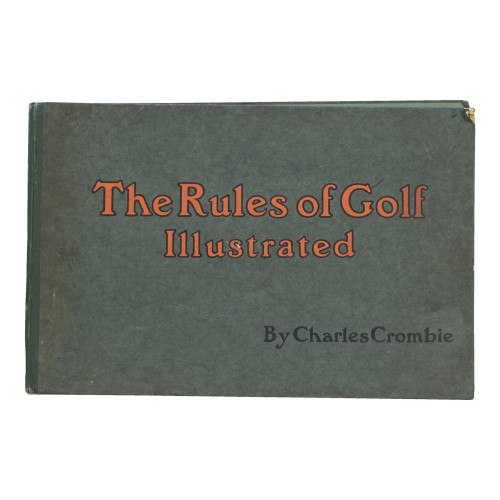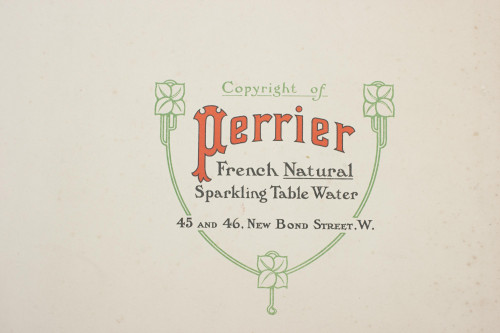- Home
- Golf
- Artwork, Paintings & Prints
- St Andrews, Life Association Print By Michael Brown
St Andrews, Life Association Print By Michael Brown
St Andrews, Life Association Print By Michael Brown
29436
Michael Brown Life Association Golf Photogravure, St. Andrews - High Hole.
A golf photogravure after Michael Brown: St. Andrews - High Hole. (Coming Home), from his famous series of scenes commissioned by the Life Association of Scotland for their 1912 calendar. It features Mr. Guy Campbell, Mr. L.M. Balfour-Melville, Mr. J.L. Low and Mr. Edward Blackwell.
The print is in a new mount with protective cellophane, size 35 cm high, 49 cm wide.
Leslie Balfour-Melville (9 March 1854 - 17 July 1937), born Leslie Balfour, was a Scottish amateur sportsman, serving as captain, opening batsman, and wicket-keeper for the Scotland national cricket team. Balfour-Melville was also an international rugby union player, tennis player, ice skater, curler, long-jumper, and player of English billiards. He was a prolific golf medal winner, winning The Amateur Championship, at St Andrews in 1895. He also held several administrative positions within national governing bodies. He was President of the Scottish Rugby Union, President of the Scottish Cricket Union, and Captain of The Royal and Ancient Golf Club of St Andrews in 1906. (Wikipedia)
Edward Baird Hay Blackwell (21 July 1866 - 22 June 1945) was a Scottish amateur golfer who played in the late 19th and early 20th century. He was a member of The Royal and Ancient Golf Club of St Andrews and finished in second place in the 1904 Amateur Championship contested at Royal St George's Golf Club in Sandwich, England. Although playing fine golf throughout, he eventually lost the final match to Walter Travis by the score of 4 and 3. He was known as a long hitter of the ball, often outdriving opponents by 50 yards or more. In 1898, Blackwell was described as probably the most consistently long driver the world had ever seen. As a result, his name became a household word among golfers. (Wikipedia)
The Life Association of Scotland was established in 1838 in Edinburgh. In the late 1800's golf courses were being established all over Scotland and the financial community set up the Insurance & Banking Golf Club on the Duddingston estate in 1895, beneath the spectacular backdrop of the extinct volcano, Arthur's Seat. To mark the opening of the extended Club House, Michael Brown was commissioned to paint a scene from an exhibition golf match at the Club. The 1899 Life Association of Scotland calendar used this image as its center piece. It was such a marketing success Brown was then commissioned to annually paint a golfing picture until 1916, prints were made of these originals and glued to the cardboard calendar that the Life Association of Scotland produced. Brown's original paintings adorned the walls of the Edinburgh head office for many years.
St Andrews "The Home of Golf" is on the Fife Coast of eastern Scotland and is considered the oldest and most iconic golf course in the world. The Old Course is 6721 yards with a par of 72. It is famous for the 'Swilcan Bridge' spanning the first and 18th holes and 'Hell Bunker'. Everyone who plays the 18th hole walks over the 700-year-old bridge, with it featuring in many iconic pictures of St Andrews. The Old Course remains a public golf course, open to all and apart from the clubhouse for the Royal and Ancient, there are clubhouses overlooking the links for The St Andrews Golf Club (1843) and The New Golf Club St Andrews (1902) for men and the St Rule Club (1896) and St Regulus Ladies Golf Club (1913) for women.
The Old Course was pivotal to the development of golf and how the game is played today. By 1754, St Andrews consisted of twelve holes, ten of which were played twice, making a round of twenty-two holes in all. The members deciding that the first four and last four holes on the course were too short combined them into four holes (two in and two out). St Andrews then became the first 18-hole golf course in the world, and a blue print for the modern course.
In 1863 the R&A appointed 'Old' Tom Morris as Custodian of the Links and with the skills he had learnt at his time in Prestwick, he went about rejuvenating St Andrews. He established separate tee boxes on each hole, the fairways were widened, the greens enlarged and two new ones were constructed. The hazards were actively managed (before then hazards and bunkers had been left to mother nature) all of this spread out play over larger areas, thus increasing the volume of golf being played at St Andrews. Tom introduced the concept of top-dressing greens with sand, was the first to use a push mower to cut greens and all the time this was helping to improve the quality of the course. He also owned a shop and workshop at 8 The Links, which still exists.
Dimensions:
1900-1949
1912
Photogravure
United Kingdom
The mount is covered with protective cellophane, hence some shadows and lines on the images. The photogravure is in very good order.
Thank you for your enquiry.
We will get back to you soon.
Please create wishlist to add this item to
RELATED ITEMS






























